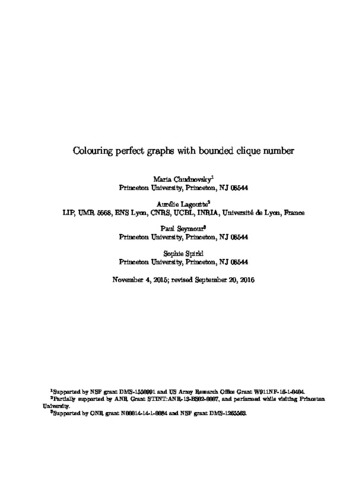| dc.contributor.author | Chudnovsky, Maria | |
| dc.contributor.author | Lagoutte, Aurélie | |
| dc.contributor.author | Seymour, Paul | |
| dc.contributor.author | Spirkl, Sophie | |
| dc.date.accessioned | 2022-08-12 00:32:29 (GMT) | |
| dc.date.available | 2022-08-12 00:32:29 (GMT) | |
| dc.date.issued | 2017-01 | |
| dc.identifier.uri | https://doi.org/10.1016/j.jctb.2016.09.006 | |
| dc.identifier.uri | http://hdl.handle.net/10012/18515 | |
| dc.description | The final publication is available at Elsevier via https://doi.org/10.1016/j.jctb.2016.09.006. © 2017. This manuscript version is made available under the CC-BY-NC-ND 4.0 license http://creativecommons.org/licenses/by-nc-nd/4.0/ | en |
| dc.description.abstract | A graph is perfect if the chromatic number of every induced subgraph equals the size of its largest clique, and an algorithm of Grötschel, Lovász, and Schrijver [9] from 1988 finds an optimal colouring of a perfect graph in polynomial time. But this algorithm uses the ellipsoid method, and it is a well-known open question to construct a “combinatorial” polynomial-time algorithm that yields an optimal colouring of a perfect graph.
A skew partition in G is a partition (A, B) of V(G) such that G[A] is not connected and G[B] is not connected, where G denotes the complement graph; and it is balanced if an additional parity condition on certain paths in G and G is satisfied.
In this paper we first give a polynomial-time algorithm that, with input a perfect graph, outputs a balanced skew partition if there is one. Then we use this to obtain a combinatorial algorithm that finds an optimal colouring of a perfect graph with clique number k, in time that is polynomial for fixed k. | en |
| dc.description.sponsorship | Supported by NSF grant DMS-1550991 and US Army Research Office Grant W911NF-16-1-0404. Partially supported by ANR Grant STINT: ANR-13-BS02-0007, and performed while visiting Princeton University. Supported by ONR grant N00014-14-1-0084 and NSF grant DMS-1265563. | en |
| dc.language.iso | en | en |
| dc.publisher | Elsevier | en |
| dc.rights | Attribution-NonCommercial-NoDerivatives 4.0 International | * |
| dc.rights.uri | http://creativecommons.org/licenses/by-nc-nd/4.0/ | * |
| dc.subject | colouring algorithm | en |
| dc.subject | perfect graph | en |
| dc.subject | balanced skew partition | en |
| dc.title | Colouring perfect graphs with bounded clique number | en |
| dc.type | Article | en |
| dcterms.bibliographicCitation | Chudnovsky, M., Lagoutte, A., Seymour, P., & Spirkl, S. (2017). Colouring perfect graphs with bounded clique number. Journal of Combinatorial Theory, Series B, 122, 757–775. https://doi.org/10.1016/j.jctb.2016.09.006 | en |
| uws.contributor.affiliation1 | Faculty of Mathematics | en |
| uws.contributor.affiliation2 | Combinatorics and Optimization | en |
| uws.typeOfResource | Text | en |
| uws.peerReviewStatus | Reviewed | en |
| uws.scholarLevel | Faculty | en |


